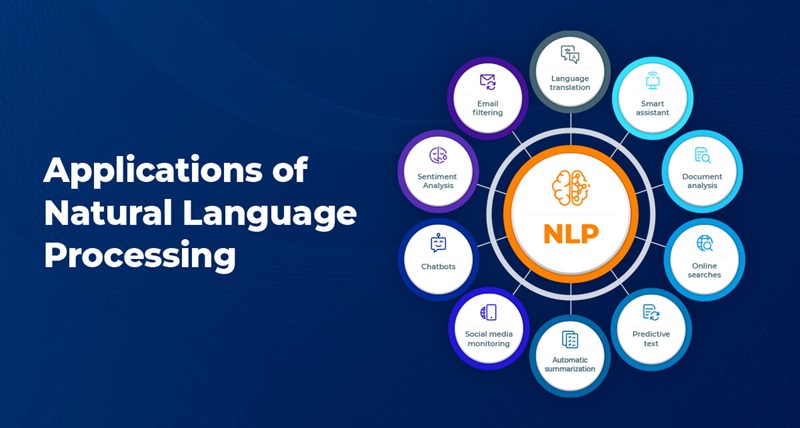
Any company seeking to improve customer experience while making data-driven choices in today’s business environment has to understand consumer sentiment. Natural language processing (NLP) has been one of the most effective methods used by businesses to examine this sentiment. Natural language processing (NLP) is a field of artificial intelligence (AI) that studies how computers and human language interact. It makes it achievable for computers to meaningfully comprehend, interpret, and react to human language. Businesses have been overwhelmed with consumer feedback through reviews, comments, and polls as a result of the growth of social media and digital platforms. Through efficient analysis of consumer sentiment, natural language processing (NLP) enables enterprises to obtain valuable insights from unstructured data.
This blog will discuss applications of Natural Language Processing (NLP), its latest developments, and the way it may be used to evaluate consumer sentiment. In order to help organizations remain ahead of the competition, we will also offer practical insights on how to use the potential of NLP.
What is Sentiment Analysis?

A specific branch of NLP called sentiment analysis looks for the feelings that are expressed in a particular text. It classifies the feeling as neutral, negative, or positive. Occasionally, it explores further to identify certain feelings like happiness, frustration, or anger. Businesses are using sentiment analysis on an increasing basis to learn how consumers feel about their goods, services, and overall brand experience.
Sentiment analysis can be used with a variety of text data formats, such as:
- Customer reviews
- Social media posts
- Survey responses
- Support tickets and emails
Businesses have the ability to assess enormous volumes of text data and get valuable insights by using sentiment analysis, which is much more accurate and efficient through the use of NLP.
The Role of NLP in Customer Sentiment Analysis
By automating the process of learning to understand and interpret human language, Natural Language Processing (NLP) plays an essential part in consumer sentiment analysis. While Named Entity Recognition (NER), text classification, tokenization, and part-of-speech tagging are examples of NLP approaches that have made it feasible to automate sentiment analysis tasks that were previously done by hand.
NLP can be utilized in analysis of sentiment in the following ways:
- Text Preprocessing: One of the most important and initial stages is this one. Stopwords (such “the” and “is”), punctuation, and numerals are among the unnecessary components that NLP algorithms eliminate from the data in order to make it cleaner. Lemmatizations along with stemming are further procedures in the above procedure that reduce words to their most basic forms (for example, “running” becomes “run”). NLP makes sure that the evaluation is more accurate by preparing text data.
- Feature Extraction: Key characteristics are extracted from the text data by NLP models following pre-processing. Algorithms for machine learning can comprehend text by converting it into numerical characteristics using techniques like Bag of Words (BoW) and TF-IDF (Term Frequency-Inverse Document Frequency). Modern methods that encode words in dense vectors and capture the semantic links between them, such as word embeddings (e.g., Word2Vec, GloVe, BERT), have become more and more popular recently.
- Sentiment Classification: The text is categorized into positive, negative, and neutral groups once the data has been pre-processed and characteristics have been extracted. Text sentiment is classified using supervised methods of machine learning such as Support Vector Machines (SVM), Naive Bayes, and Deep Learning models like Recurrent Neural Networks (RNNs) and Transformer models (e.g., BERT, GPT).
- Emotion Detection: Certain emotions in the text can be identified by more sophisticated NLP algorithms. Determining the customer’s state of mind involves figuring out if they are joyful, depressed, angry or disappointed. Deeper understanding of the motives and emotions of customers is possible with this degree of sentiment analysis.
Applications of NLP-Based Sentiment Analysis in Business

A variety of businesses make use of sentiment analysis based on Natural Language Processing (NLP) to find out more regarding the preferences and behaviour of its customers. Some practical uses are listed below:
- Customer Feedback Analysis: Businesses may look at feedback from clients and survey results to learn what aspects of their goods and services people find beneficial or problematic. By doing this, businesses may improve user experience, customer service, and product design by making data-driven decisions.
- Brand Monitoring: Businesses can implement sentiment analysis in order to monitor brand mentions and get real-time information into consumer sentiment on social media platforms like Facebook, Instagram, and Twitter. These platforms are valuable forums for customers to voice their thoughts about brands.
- Market Research: Businesses may gain insights into the customer’s opinion of competitors and market developments through the use of sentiment analysis. Companies are able to pinpoint opportunities for product or service enhancement as well as gaps in the market by studying sentiment data.
- Customer Service: In customer service, Natural Language Processing (NLP) is used to evaluate the tone of emails, chat conversations, and support issues. Businesses are able to give priority to negative or urgent tickets, guaranteeing a prompt response. Using Natural Language Processing (NLP), automated chatbots can recognize the mental state of their users and tailor their responses appropriately.
- Product Improvement: Businesses can find ways to improve satisfaction or common issues by studying consumer feedback; these insights may then be utilized to inform future product development. Product teams may prioritize improvements by using sentiment analysis to learn what features consumers like and dislike.
Recent Advancements in NLP for Sentiment Analysis

The development of Transformer models such as BERT (Bidirectional Encoder Representations from Transformers) and GPT (Generative Pre-trained Transformer) has led to significant advances in the field of Natural Language Processing (NLP). By providing improved accuracy and contextual knowledge of human language, these models have completely changed the way sentiment analysis is carried out.
1. Transformer Models
Modern sentiment analysis models are transformers, specifically BERT and GPT. Transformers are able to record word connections in both directions (left-to-right and right-to-left), in contrast to standard models that analyze text sequentially. The accuracy of sentiment analysis algorithms has greatly increased as a result of this capacity to comprehend context.
2. Sentiment Fine-tuning
Businesses can create extremely accurate sentiment analysis tools that are customized to their sector by fine-tuning pre-trained models like BERT on particular datasets. The accurateness of sentiment forecasts in specialized industries like healthcare, banking, or retail is increased by this change in methodology.
3. Multilingual Sentiment Analysis
Sentiment analysis across various languages is now possible because to recent advancements in NLP models. This function is essential for extracting information from non-English text data, especially for multinational corporations that interact with multilingual clients. Businesses may better grasp the opinions of a broad client base through the use of models such as M-BERT (Multilingual BERT), which processes sentiment analysis in more than 100 different languages.
4. Aspect-Based Sentiment Analysis (ABSA)
By recognizing certain features of a good or service and evaluating the sentiment related to each feature, ABSA goes beyond simple sentiment analysis. Businesses trying to make specific changes will find this level of research to be quite helpful.
Challenges in NLP-Based Sentiment Analysis
Even though NLP-based sentiment analysis has grown significantly, there are still a number of challenges to overcome:
- Sarcasm Detection: One of the most difficult tasks for NLP models to deal with is sarcasm. Although phrases like “Great, another bug in the app” may appear to be pleasant at first glance, they really convey a negative message. Many models still struggle to fully grasp context, which is necessary for sarcasm detection.
- Ambiguity in Language: Because of the inherent uncertainty of human language, the same word or phrase could refer to multiple things according to the situation. It can be challenging to effectively train NLP models to deal with these complexities when working with complicated or domain-specific language.
- Contextual Understanding: Even though contextual awareness in the transformer models has improved, many models are still able to properly understand the context, particularly in texts that are long. Shorter writings, like reviews or tweets, often get incorrectly categorized since there is little context.
Future Trends in NLP and Sentiment Analysis

With further research aimed at improving the accuracy and efficiency of models, sentiment analysis and Natural Language Processing appear to have a bright future. Important developments to keep an eye on are:
- Real-Time Sentiment Analysis: Real-time sentiment analysis is going to become increasingly common as real-time data streams through social media and other platforms grow in popularity. Businesses would be able to track client opinion in real time, allowing for forward-thinking responses.
- Explainable AI in Sentiment Analysis: Explainable models will become more and more sought after as organizations depend more and more on based on artificial intelligence sentiment analysis. By revealing the process behind a sentiment forecast, these models will increase openness and confidence in artificial intelligence.
- Emotion AI: It is anticipated that future NLP models would be able to identify distinct emotions such as happiness, sadness, and frustration in addition to positive, negative, and neutral attitudes. Businesses may gain a deeper understanding of the emotional factors influencing consumer behaviour by utilizing emotion AI.
Conclusion
It is now required for organizations to implement Natural Language Processing to evaluate client sentiment, not just a luxury. Companies may now improve their goods and services, increase customer happiness, and get important insights from consumer feedback because of the quick developments in NLP technology. Using sentiment analysis based on Natural Language Processing (NLP) may provide any organization, big or small, a competitive edge in customer understanding and well-informed decision-making.
Businesses might make sure that stay ahead in today’s fast-paced, customer-centric environment by incorporating contemporary NLP approaches and keeping up to date on the latest developments.
Read Also:- Blockchain’s Role in Transparent Global Supply Chains || How To Improve My Legal Research And Writing Skills?

